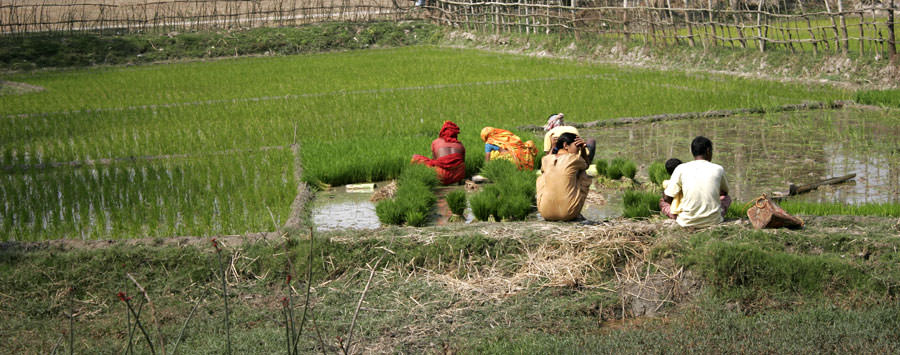
Rural distress
What's Inside
KEY TRENDS
• The report entitled Pradhan Mantri Fasal Bima Yojana: An Assessment from the Centre for Science and Environment (released on 21 July, 2017) finds that PMBY is not beneficial for farmers in vulnerable regions. For farmers in vulnerable regions such as Bundelkhand and Marathwada, factors like low indemnity levels, low threshold yields, low sum insured and default on loans make PMFBY a poor scheme to safeguard against extreme weather events. CSE's analysis shows that farmers in these areas might not get any claim even if more than half of their crops are damaged @@
• The CAG report on Performance Audit of Agriculture Crop Insurance Schemes (Report no. 7 of 2017), which was tabled in the Parliament on 21 July, 2017, finds that despite the three decade long efforts of Government of India to provide crop insurance, coverage of farmers under such schemes continues to remain low. The coverage of non-loanee farmers continues to be particularly low, primarily because the schemes have been targeted at loanee farmers, for whom the schemes stipulate mandatory coverage @$
• Within the rural households, the marginal land owners (i.e. possessing more than 0.002 but less than or equal to 1.0 hectare of land) constituted the highest proportion(75.42%) of total rural households, whereas the large land owners (possessing land more than 10.000 hectares) constituted the lowest proportion (0.24% ) of the total households. The landless category (possessing land less than or equal 0.002 hectare) constituted 7.41% of the total rural households $$
@@ Pradhan Mantri Fasal Bima Yojana: An Assessment from the Centre for Science and Environment (released on 21 July, 2017), please click here to access
@$ CAG report on Performance Audit of Agriculture Crop Insurance Schemes (Report no. 7 of 2017), tabled in the Parliament on 21 July, 2017 (please click here to access)
$$ Key Indicators of Land and Livestock Holdings in India, NSS 70th Round (Please click here to access)
$ State of Indian Farmers: A Report, done by Centre for the Study of Developing Societies (CSDS), Delhi (please click here to download)
# Some Aspects of Farming, 2003, Situation Assessment Survey of Farmers, National Sample Survey (NSS) 59th Round, (January–December 2003)
" Some Aspects of Operational Land Holdings in India, 2002-03, Report No. 492(59/18.1/3), National Sample Survey 59th Round (January–December 2003), August, 2006
*# World Development Report: Agriculture for Development 2008, www.worldbank.org
* Nagaraj, K (2008): Farmers’ Suicides in India, Magnitudes, Trends and Spatial Patterns, Macroscan
@ NCEUS (2007), Report on Conditions of Work and Promotion of Livelihoods in the Unorganised Sector OVERVIEW We are told that India withstood global recession on the strength of its rural market. While it is true that rural India’s potential for consumption is huge, the country is not even close to realizing it. According to NSSO almost one third farmers don’t like farming and about 40 per cent say given a choice they would do something else. Nothing reflects the farmers’ falling standards of living better than their calorie intake which has fallen (for the entire rural population) from 2309 Kcal per day in 1983 to 2011 Kcal per day in 1998, a drop of over 15 per cent in as many years. Rural India’s perverse appetite for gold and motorbikes, mainly to be given away as dowry, is fed by borrowings and non-farm incomes. With average landholding falling from 2.6 hectares per farmer in 1960 to 1.4 hectares in 2000 due to fragmentation, farming continues to be an utterly unprofitable activity. The wealthy and powerful zamindar of the Bollywood movies remains a creature of our imagination. The ‘poor’ rich farmer with over 10 hectares of land is below one per cent in poorer states like Bihar and Bengal and around 8 per cent in relatively prosperous Punjab and Haryana. The rest are all small, marginal and medium farmers battling for survival against tough odds. Over 60 per cent of India’s cultivated area is rain-fed and is untouched by the fruits of the Green Revolution. The fabled Green Revolution did end India’s depended on foreign aid to feed its people. But its gains were confined to about a third of the country’s cultivated area covered under irrigation schemes. Even in these areas, the farm crisis has since deepened due to high input costs, lowering of the water table, degradation of soil fertility and unrewarding pricing mechanisms. As a result the growth in food grain production has tumbled from 3.5 per cent in the eighties to 1.8 per cent in the nineties. Farmers’ suicides, which were virtually unknown in the eighties, and which were once thought to be a regional syndrome of the poorer regions, are now spreading to relatively prosperous areas like Punjab, Haryana, Karnataka and Kerala. For the poorest and rain dependent farmers the profitability has dropped further. Input costs have consistently risen and the crisis is further aggravated by the absence of fair credit agencies, scientific seed banks and vital services like education and health. India’s much maligned agricultural subsidy per farmer is not even one hundredth of corresponding subsidies given to the OECD farmers. (India’s per farmer subsidy is $ 66 as against $26000 in Japan, $ 21000 in the US and $ 11000 in the OECD countries) |
Rural Expert










Write Comments